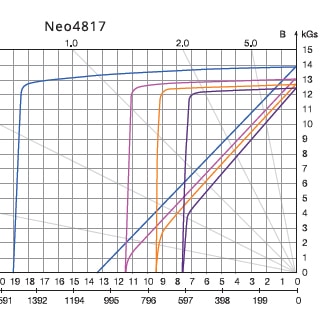Our technical experts are ready to answer your questions and address your magnetic needs. Whether it’s selecting a magnet to fit an application, choosing the most cost effective material or reviewing options from what is available in the market, we are here to help with:
- Application and Design Engineering Assistance
- Testing/Analysis of Magnetic Materials
- Magnetic Circuit Analysis/FEA
- Value Analysis/Value Engineering Support
- Inventory Management Programs
Demagnetization Curves

Magnet Stabilization and Calibration
If you need to ensure magnetic stability over temperature range, or tight tolerances on flux output, we have a great whitepaper covering this topic. It is intended for manufacturers that use permanent magnets and need magnets or assemblies that are magnetically stable over the expected temperature range of use or those manufacturers requiring magnets to perform within a very tight tolerance of flux output. Read more.
Resources
Adams Stock Products Catalog 2018
We are delighted to share our 2018 catalog with you. We’ve added updated information about our fabrication capabilities, available in Elmhurst, IL and Carlsbad, CA. We’ve also added new neodymium holding assemblies, a MAGbond Magnetic Media System overview, and high energy wide-format magnetic sheet (40″ wide and still printable!). If you’d prefer to receive a hard copy of this catalog, let us know.
Adams Hard Magnet Materials Catalog updated 2020
(7MB) This PDF catalog features a magnet materials overview, chart of materials properties and demagnetization curves for Neodymium, Samarium Cobalt, Ceramic (Ferrite) and Alnico materials offered by Adams. New in 2020, we’ve added more curves, and a coatings chart to assist with corrosion protection decisions.
Chart of Material Properties
Displays each permanent magnet material along with its Maximum Energy Product: Bhmax, Residual Flux Density: Br Gauss, Coercive Force: Hc Oersteds, Intrinsic Coercive Force: Hci Oersteds and Maximum Operating Temperature: C / F.
Breakaway Force of a Magnet
Explains the test methods used to determine how much force it takes to pull a magnet directly away from the surface it is attached to.
Samarium Cobalt Product Specifications
Samarium Cobalt (or SmCo) magnets are strong permanent magnets made of an alloy of samarium and cobalt. They are known for their high magnetic strength, exceptional temperature resistance, and reliable performance without oxidation protection. As a result, they are more suitable for certain applications than Neodymium magnets.

Adams TabMAG® Neodymium with Adhesive Product Specifications
Adams offers TabMAG® Neodymium discs and rectangles with adhesive on one side. They are commonly used in packaging, box closure, display, and door latch applications. This PDF gives an overview of our most popular TabMAG® magnets.

Standard Specifications for Permanent Magnet Materials
Defines thermal and mechanical characteristics and properties of commercially available permanent magnet materials including Alnico, Ceramic, Rare Earth (Samarium cobalt and neodymium) and Iron-Chromium-Cobalt. Includes a Glossary of Terms and Magnetic Quantities (Symbols, Units and Conversion Factors).





